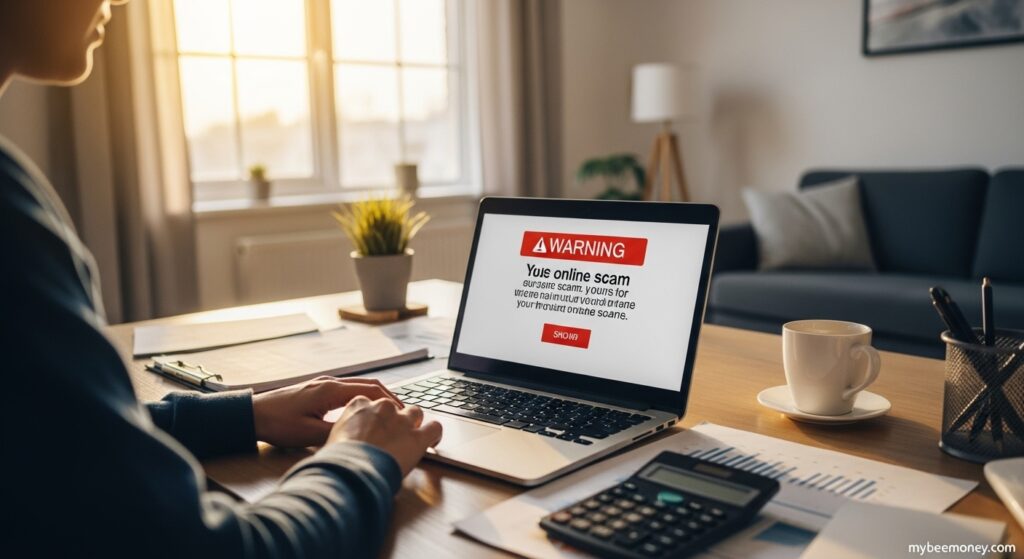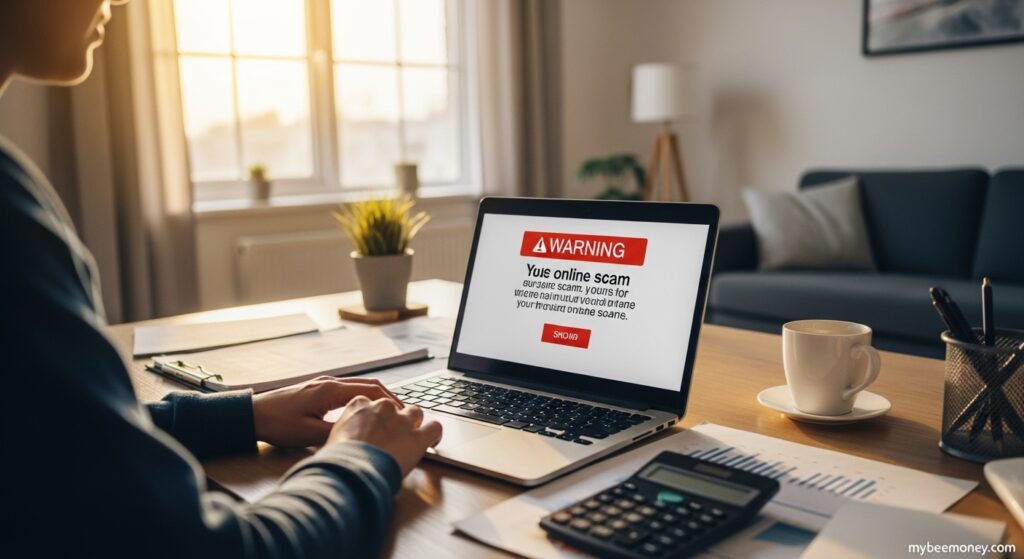
Hey, imagine waking up to find your bank account drained because of a sneaky online scam—scary, right? As a young adult just starting out, whether you’re fresh out of college or hustling in your first job, losing your hard-earned cash is a nightmare you can’t afford.
That’s why I’m here to help you protect your finances from digital crooks. In this post, you’ll learn simple, practical tips to safeguard your money and avoid common traps. Let’s dive in and keep your wallet safe!
Understand the Threat of Online Scams
Hey, before you can protect your money, you’ve got to know what you’re up against. Online scams are everywhere, and they’re getting sneakier by the day. Let’s break down the dangers so you’re not caught off guard.
These threats aren’t just random; they’re designed to trick you. Scammers prey on trust and inexperience, and understanding their tactics is your first line of defense.
Stick with me as we dive into the most common scams, how they target beginners, and some real-life stories that’ll make you think twice.
This quick guide will arm you with the basics to spot trouble before it hits your wallet. Let’s get started with the details below!
Common Types of Financial Scams Online
First up, let’s talk about the usual suspects in the online scam world. Phishing emails are huge—those fake messages pretending to be your bank, asking for your password. Then there’s investment fraud, promising quick riches if you just send money now.
Another nasty one is romance scams, where someone fakes a relationship to drain your funds. Scammers are crafty, often using urgent language to rush you. Watch out for anything that feels off!
How Scammers Target Beginners in Finance
If you’re new to managing money online, you’re a prime target. Scammers love to exploit your lack of experience with fake “get-rich-quick” schemes or too-good-to-be-true offers. They’ll often pose as financial advisors or tech support.
They might send you links to fake websites that steal your info. Or they’ll pressure you into sharing personal details. Always double-check before clicking or sharing anything sensitive!
Here’s a quick list of red flags to watch for:
- Urgent requests for money or info.
- Unknown senders claiming to know you.
- Deals that seem unrealistically good.
Real-Life Examples of Scam Victims
Hearing about real people getting scammed hits hard. Take Jane, a retiree who lost $10,000 to a fake investment site promising huge returns. She trusted a slick website and ignored the warning signs.
Then there’s Mike, a college student, who got tricked by a phishing email mimicking his bank. He shared his login, and his savings vanished overnight. These stories, often reported by outlets like CNN Money, show anyone can be a victim.
So, stay sharp and question everything. One wrong click can cost you big time!
Build Strong Digital Security Habits

Hey, protecting your money online isn’t just about knowing the threats—it’s about building habits that keep you safe. Digital security is like locking your front door; you’ve got to do it every day to stay protected.
Let’s dive into some practical ways to beef up your defenses. These simple steps can make a huge difference in keeping scammers at bay.
We’ll cover a few key habits that are easy to adopt. Stick with these, and you’ll be a tough target for online crooks.
Use Strong Passwords and Two-Factor Authentication
First off, your passwords are your first line of defense. Don’t use “password123” or your pet’s name—make them complex with letters, numbers, and symbols.
Also, enable two-factor authentication (2FA) wherever possible. This adds an extra step, like a code sent to your phone, making it harder for hackers to get in.
Even if someone guesses your password, 2FA can stop them cold. Most banks and apps offer this—turn it on now!
Avoid Public Wi-Fi for Financial Transactions
Public Wi-Fi at cafes or airports might be convenient, but it’s a playground for hackers. Avoid logging into your bank or shopping online using these networks.
If you must use public Wi-Fi, get a VPN (Virtual Private Network) to encrypt your data. It’s like a shield for your info.
Scammers can intercept your details on unsecured networks. So, save those financial transactions for a secure connection at home.
Regularly Update Your Software and Apps
Keeping your apps and devices updated isn’t just about new features—it’s about security patches. Updates often fix vulnerabilities hackers exploit.
Set your phone and computer to update automatically if you can. It’s one less thing to worry about.
Outdated software is like leaving your window open. A report by Cybersecurity Ventures shows outdated systems are a top entry point for attacks.
Here’s a quick checklist to stay on top of updates:
- Check for software updates weekly.
- Enable auto-updates on all devices.
- Don’t ignore app update notifications.
Spot Red Flags in Suspicious Communications
Hey, let’s talk about spotting those sneaky signs in messages that scream “scam!” Online crooks are crafty with their words, and knowing what to look for can save you from a major headache.
Scammers often hide behind emails, texts, or calls that seem legit at first glance. But there are telltale clues if you pay attention. Let’s break down the key red flags to watch for in suspicious communications.
This isn’t just about being paranoid—it’s about being smart. I’ll walk you through the biggest warning signs in the sections below.
Stick with me here, and you’ll be dodging scams like a pro in no time!
Identify Phishing Emails and Fake Messages
First up, let’s tackle phishing emails and fake texts. These are messages pretending to be from trusted sources like your bank or a retailer, but they’re after your info.
Look for weird email addresses or typos in the message. Scammers often use domains like “y0urbank.com” instead of “yourbank.com”—see the difference?
Also, hover over links (don’t click!) to check where they lead. If it’s not the official site, it’s a trap.
Watch for Urgency Tactics in Scam Attempts
Scammers love creating panic with urgency tactics. They’ll say stuff like “Act now or lose your account!” to rush you into mistakes.
Take a breath if a message pushes you to click or reply instantly. Legit companies rarely demand immediate action via email or text.
Real-world example: a fake IRS email claiming you owe taxes and must pay now. The real IRS doesn’t email like that—always double-check.
Verify Sender Identity Before Responding
Finally, always verify who’s really contacting you. Scammers spoof caller IDs or email addresses to look like someone you trust, like your boss or a friend.
If something feels off, don’t reply right away. Call or email the person using a known contact, not the one in the suspicious message.
Here are quick tips to stay safe:
- Double-check email addresses for subtle misspellings.
- Use official websites or apps to log in, never links from messages.
- Trust your gut—if it feels fishy, it probably is.
Stay sharp, and don’t let scammers catch you off guard!
Protect Your Financial Accounts Effectively
Hey, keeping your money safe isn’t just about spotting scams—it’s about locking down your financial accounts too. Let’s dive into some practical steps to make sure no one messes with your hard-earned cash.
Your bank and credit card accounts are prime targets for scammers. By taking a few proactive measures, you can stay one step ahead of fraudsters.
I’ve broken this down into three key areas to focus on. Check them out below and start securing your finances today!
Monitor Bank and Credit Card Activity Often
Don’t just set and forget your accounts—keep an eye on them! Checking your bank statements and credit card activity weekly can help you spot unauthorized charges fast.
It’s super easy to miss a small, sneaky transaction if you’re not looking. For example, a random $5 charge could be a test before a bigger hit.
Use your bank’s app or website to review transactions. If anything looks off, report it immediately to avoid bigger losses.
Set Up Alerts for Unusual Transactions
Most banks let you set up alerts for suspicious activity—use them! You’ll get a text or email if a big purchase or weird login happens.
This is a game-changer for catching fraud in real-time. Imagine getting a ping about a $500 purchase you didn’t make—boom, you can act fast.
Log into your account and enable notifications for withdrawals, large transactions, or logins from new devices. It’s a small step with huge protection.
Here’s how to get started with alerts:
- Log into your bank or credit card portal.
- Find the “Notifications” or “Alerts” section.
- Customize alerts for transactions over a set amount.
Freeze Accounts if You Suspect Fraud
If something feels off, don’t wait—freeze your accounts! Most banks let you temporarily lock your card or account with a quick call or app tap.
This stops scammers in their tracks while you sort things out. For instance, if you lose your card, freezing it prevents any sneaky charges.
Contact your bank right away to report the issue. They’ll guide you on next steps, like replacing a card or disputing charges.
Remember, acting fast is key. A frozen account is way better than an empty one!
Know What to Do After a Scam Incident

Hey, falling for a scam can happen to anyone, and it’s not the end of the world. The key is knowing how to react quickly to minimize damage and protect yourself moving forward.
Don’t panic, but don’t waste time either. Taking immediate action can make a huge difference in recovering your money or securing your accounts.
This section will guide you through the critical steps to take right after a scam. Let’s break it down into actionable tips to get you back on track.
Stick with me here as we dive into reporting the incident, securing your finances, and learning from the experience.
Report the Scam to Authorities Quickly
First things first, you’ve got to report the scam as soon as you realize it. Contact local authorities or file a complaint with agencies like the Federal Trade Commission (FTC) in the US.
Reporting helps track scammers and might even assist in recovering losses. Plus, it protects others from falling into the same trap.
Don’t hesitate, even if you feel embarrassed. According to a report by the FTC, millions of scam cases go unreported each year, letting crooks roam free.
Head to their website or call their hotline. Every detail you provide counts in building a case against these fraudsters.
Contact Your Bank to Secure Accounts
Next up, get in touch with your bank or credit card provider immediately. Let them know what happened so they can freeze or monitor your accounts for suspicious activity.
Most banks have fraud departments ready to help. They might reverse transactions if you act fast enough, saving you from bigger losses.
Ask them to issue new cards or change your PINs. Also, check your statements for unauthorized charges that might’ve slipped through.
Time is critical here. The sooner you call, the better your chances of protecting your hard-earned cash.
Educate Yourself to Prevent Future Scams
Finally, turn this bad experience into a learning opportunity. Take a moment to understand how the scam happened so you can avoid it next time.
Here are a few quick tips to stay sharp:
- Double-check links before clicking—hover to see the real URL.
- Never share personal info like passwords or Social Security numbers.
- Stay updated on common scams through reliable sources like the FTC website.
Knowledge is your best defense. Read up on new scam tactics and share what you learn with friends or family.
Remember, scammers evolve, but so can you. Keep your guard up, and you’ll be way harder to trick in the future.
Conclusion
Hey, protecting your finances from online scams is totally doable! Remember to stay sharp, double-check suspicious links or emails, and keep your personal info locked down. These simple steps can save you a ton of stress.
So, take control now—review your security habits today. Don’t wait for a scam to hit. Are you ready to safeguard your money for good?
faq: How to Protect Your Finances from Online Scams
How can I spot a fake website before entering my info?
Look for “https://” and a padlock icon in the address bar. Also, check for weird spellings or extra characters in the URL that might indicate a scam.
What should I do if I think I’ve been scammed online?
Contact your bank or credit card provider immediately to freeze your accounts. Report the incident to authorities like the FTC to help track the scammer.
Are there tools to help protect me from online scams?
Yes, use antivirus software with real-time threat detection. Browser extensions like anti-phishing tools can also warn you about risky sites.
Should I share my financial details over the phone?
Never share sensitive info like bank details or PINs over the phone. Legit companies won’t ask for this without secure verification first.
How often should I check my bank accounts for fraud?
Check your accounts at least weekly for unusual activity. Set up alerts with your bank to get instant notifications of suspicious transactions.












